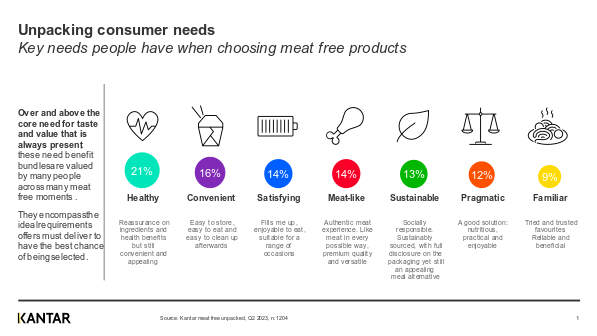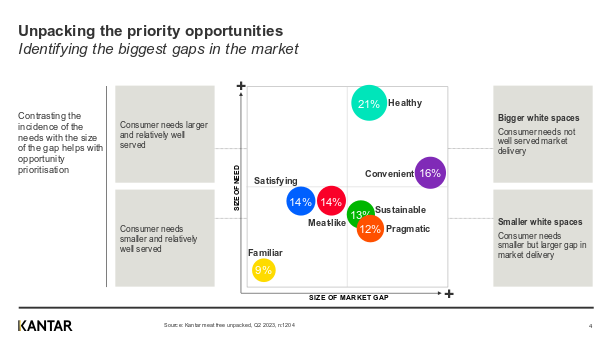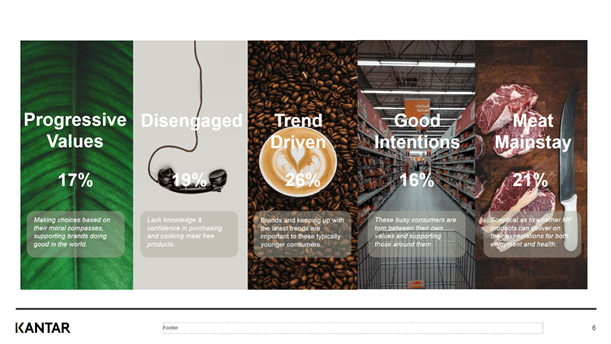In the news a recent focus was the prediction that the UK is likely to have the highest inflation rate out of all the G20 counties in 2023. Prices are on the up and brands will need to work hard to justify increases.
In my last article in the #BrandStrategyUnpacked series, I focused on the need to design for #difference in order to drive perceptions of value. Kantar evidence has shown that meaningful difference is the key to value creation - it drives perceptions of being worth paying more for and is integral to building pricing power.
For those in the pursuit of difference, I offered up some tangible ingredients, namely (1) being clear on your brand’s core, beyond product; and (2) having the discipline to always show up consistently, so that (3) you build on and reinforce brand memories in every reinvention.
The thing we haven’t yet talked about is how brands create meaning or stay #meaningful? How do brands figure out how to drive affinity and meet needs in a market?
Finding meaning and staying meaningful means walking a constant treadmill in a world that is always shifting and changing. In the UK #meatfree market 8 out of the 13 brands we looked at lacked meaning. For these brands there is an opportunity to drive brand power and perceptions of value by being more meaningful.
To understand the opportunities we unpacked the meat free market in two ways.
1. We segmented consumer needs to determine what people want on the occasions in which they eat meat free and whether there were opportunity gaps to fill with innovation and renovation.
2. We also segmented the people who currently buy in to the market to help understand who brands can target in this category and how they might be able to resonate with different audience groups.
Unpacking consumer needs
Reassuringly, outcomes of our #needsegmentation weren’t at odds with some of the topline indicators we had pulled out in a previous article. But using a more rigorous approach we were able to unpack rich detail on what people want and how well the market is delivering to these needs.

Over and above the core needs for taste and value that are always present, we found seven needs benefit bundles that illustrate what people want from the meat free category. They’re detailed in the chart below.
Healthy and sustainable, we’ve talked about before – the need for healthy options is big, much bigger than the need for sustainable options. It is so important to unpack consumer needs like this to avoid assumptions driving strategy.
We haven’t talked about the need for ‘meat-like’ products. This is need for meat free alternatives that offer an authentic meat-like experience – like meat in every possible way. We can see brands catering for this. A salient example is the innovative #THIS ISN’T BACON RASHERS. They start life as soya beans and peas and end up looking very much like a bacon rasher. There is a definite need for this kind of offer, it’s about as relevant as sustainable options. And it might be an attractive avenue for brands, as we can see that people are willing to pay a bit more for meat free masquerading as the real deal. But it won’t be what everyone is looking for from meat free. Meat-like is one way to do meat free, but it is not the only way to do meat free.

To understand the opportunities and gaps in the meat free market, we mapped how well brands are delivering to these consumer needs vs. their incidence, see the chart below. The need for ‘meat-like’ products is actually relatively well catering for in this fledgling market, whereas people’s need for convenience – making meat free easy - is least well catered for. A clear opportunity for brands.
Closing the gap in the big health need also stands out as a clear opportunity in this market. Our data shows specific gaps in ‘sources of anti-oxidants’, ‘calorie controlled portions’ and ‘helps me get more vegetables in my diet’.
Understanding consumer needs is important as it enables brands to target specific market gaps and train innovation and renovation against these ideals. Finding ways to evolve is key to driving relevance and staying meaningful.
Unpacking consumer groups
The mechanics of marketing - buying media, developing communication etc. - often mean that (as well as understanding what people want and training offer against specific consumer needs) it is helpful to have identifiable audiences with homogenous needs and attitudes to target. As such, we often complement needs understanding work with audience understanding work – the two lenses work in symbiosis with one another.
Our meat free people #segmentation identified 5 groups of people who are currently buying into this category, see topline detail on each below. Many of these groups you might have expected for example, those who are driven by their progressive values or good intentions or those who are more trend driven.

However, there is one group that you might not have expected within a set of meat free shoppers – the meat mainstay group. These people crave ‘real meat’ experiences. As such they are a bit of a contradiction! They buy into the category but are sceptical as to whether meat free alternatives can deliver against their expectations, but they are the 2nd biggest audience we identified – 21% of the market – so they are important.
Unsurprisingly, the meat free foods they buy aren’t always for personal consumption. Meat eating is very much part of how they identify, and they worry that they will be judged by others for choosing #plantbased alternatives. Many are consciously trying to reduce their meat consumption, however they enjoy and value eating meat so they find it difficult to change.
When the meat mainstayers make choices in meat free, the needs segments that are most prolific for them are that the product will be satisfying, meat-like and healthy. They would need convincing that the meat free alternatives taste as good as real meat, are really healthier for them or offer the opportunity to save money before switching.
Back to our quest for meaningful difference
Finding meaning and staying meaningful means walking a constant treadmill in a world that is always shifting and changing. Periodically taking time to stop and assess, is an important discipline in making sure you know where the opportunities are and where you want to focus to win. You want to ensure that your strategy is built on truth not assumptions.
Unpacking opportunities means understanding what people want and where the gaps are and understanding the different audiences and how your messages might resonate most effectively with them. Combining the insights using these two lenses provides laser focus on where to win.
Look out for further ways to drive meaning and difference in this market in our next #BrandStrategyUnpacked instalments. Follow the hashtag to make sure you don’t miss them.

